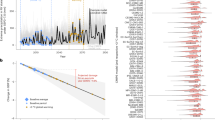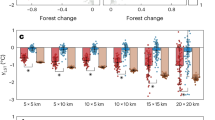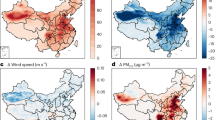Abstract
Atmospheric aerosols are of great climatic and environmental importance due to their effects on the Earth’s radiative energy balance and air quality. Aerosol concentrations are strongly influenced by rainfall via wet removal. Global climate models have been used to quantify their climate and health effects. However, they commonly suffer from a well-known problem of ‘too much light rain and too little heavy rain’. The impact of simulated rainfall intensities on aerosol burden at the global scale is still unclear. Here we show that rainfall intensity has profound impacts on aerosol burden, and light rain has a disproportionate control on it. By improving the representation of convection, the light-rain (1–20 mm d−1) frequency in two state-of-the-art global climate models is reduced. As a result, the aerosol burden is increased globally, especially over the tropics and subtropics, by as much as 0.3 in aerosol optical depth in tropical rain belts. It is attributed to the dominant contribution of light rain to the accumulated wet removal by its frequent occurrence despite its weak intensity. The implication of these findings is that understanding the nature of aerosol scavenging by rainfall is critical to aerosol–climate interaction and its impact on climate.
This is a preview of subscription content, access via your institution
Access options
Access Nature and 54 other Nature Portfolio journals
Get Nature+, our best-value online-access subscription
$29.99 / 30 days
cancel any time
Subscribe to this journal
Receive 12 print issues and online access
$259.00 per year
only $21.58 per issue
Buy this article
- Purchase on Springer Link
- Instant access to full article PDF
Prices may be subject to local taxes which are calculated during checkout




Similar content being viewed by others
Data availability
GPM data can be accessed online at https://pmm.nasa.gov/data-access/downloads/gpm. TRMM data are available from https://disc2.gesdisc.eosdis.nasa.gov/opendap/TRMM_L3/. MODIS data can be obtained at https://search.earthdata.nasa.gov and AERONET data are available at https://aeronet.gsfc.nasa.gov/new_web/data.html. The CAM and EAMv1 simulation data are provided in an open repository, Zenodo (https://doi.org/10.5281/zenodo.4259554).
Code availability
The CESM1.2.1-CAM5.3 source code can be downloaded from the CESM official website: http://www2.cesm.ucar.edu. The E3SM-EAMv1 source code is available from the E3SM official website: https://e3sm.org/. The stochastic deep-convection code is available from the corresponding author upon request.
References
Abdul-Razzak, H. & Ghan, S. J. A parameterization of aerosol activation: 2. multiple aerosol types. J. Geophys. Res. Atmos. 105, 6837–6844 (2000).
Wang, Y., Liu, X., Hoose, C. & Wang, B. Different contact angle distributions for heterogeneous ice nucleation in the Community Atmospheric Model version 5. Atmos. Chem. Phys. 14, 10411–10430 (2014).
Wang, Y. & Liu, X. Immersion freezing by natural dust based on a soccer ball model with the Community Atmospheric Model version 5: climate effects. Environ. Res. Lett. 9, 124020 (2014).
Carslaw, K. et al. A review of natural aerosol interactions and feedbacks within the Earth system. Atmos. Chem. Phys. 10, 1701–1737 (2010).
Raes, F., Liao, H., Chen, W. T. & Seinfeld, J. H. Atmospheric chemistry–climate feedbacks. J. Geophys. Res. Atmos. 115, D12121 (2010).
Myhre, G. et al. in Climate Change 2013: The Physical Science Basis (eds Stocker, T. F. et al.) Ch. 8 (IPCC, Cambridge Univ. Press, 2013).
Boucher, O. et al. in Climate Change 2013: The Physical Science Basis (eds Stocker, T. F. et al.) 571–657 (IPCC, Cambridge Univ. Press, 2013).
Forouzanfar, M. H. et al. Global, regional, and national comparative risk assessment of 79 behavioural, environmental and occupational, and metabolic risks or clusters of risks in 188 countries, 1990-2013: a systematic analysis for the Global Burden of Disease Study 2013. Lancet 386, 2287–2323 (2015).
Xing, Y., Xu, Y., Shi, M. & Lian, Y. The impact of PM2.5 on the human respiratory system. J. Thorac. Dis. 8, 69–74 (2016).
Chowdhury, S., Dey, S. & Smith, K. R. Ambient PM2.5 exposure and expected premature mortality to 2100 in India under climate change scenarios. Nat. Commun. 9, 318 (2018).
Park, S., Allen, R. J. & Lim, C. H. A likely increase in fine particulate matter and premature mortality under future climate change. Air Qual. Atmos. Health 13, 143–151 (2020).
Silva, R. A. et al. Future global mortality from changes in air pollution attributable to climate change. Nat. Clim. Change 7, 647–651 (2017).
Rasch, P. J., Barth, M. C., Kiehl, J. T., Schwartz, S. E. & Benkovitz, C. M. A description of the global sulfur cycle and its controlling processes in the National Center for Atmospheric Research community climate model, version 3. J. Geophys. Res. Atmos. 105, 1367–1385 (2000).
Jacob, D. J. & Winner, D. A. Effect of climate change on air quality. Atmos. Environ. 43, 51–63 (2009).
Fang, Y. et al. The impacts of changing transport and precipitation on pollutant distributions in a future climate. J. Geophys. Res. Atmos. 116, D18303 (2011).
Mahowald, N., Albani, S., Engelstaedter, S., Winckler, G. & Goman, M. Model insight into glacial–interglacial paleodust records. Quat. Sci. Rev. 30, 832–854 (2011).
Racherla, P. N. & Adams, P. J. Sensitivity of global tropospheric ozone and fine particulate matter concentrations to climate change. J. Geophys. Res. Atmos. 111, D24103 (2006).
Avise, J. et al. Attribution of projected changes in summertime US ozone and PM2.5 concentrations to global changes. Atmos. Chem. Phys. 9, 1111–1124 (2009).
Kirtman, B. et al. in Climate Change 2013: The Physical Science Basis (eds Stocker, T. F. et al.) 953–1028 (IPCC, Cambridge Univ. Press, 2013).
Ackerley, D., Highwood, E. J., Frame, D. J. & Booth, B. B. Changes in the global sulfate burden due to perturbations in global CO2 concentrations. J. Clim. 22, 5421–5432 (2009).
Kloster, S. et al. A GCM study of future climate response to aerosol pollution reductions. Clim. Dyn. 34, 1177–1194 (2010).
Xu, Y. & Lamarque, J.-F. Isolating the meteorological impact of 21st century GHG warming on the removal and atmospheric loading of anthropogenic fine particulate matter pollution at global scale. Earths Future 6, 428–440 (2018).
Allen, R. J., Landuyt, W. & Rumbold, S. T. An increase in aerosol burden and radiative effects in a warmer world. Nat. Clim. Change 6, 269–274 (2016).
Allen, R. J., Hassan, T., Randles, C. A. & Su, H. Enhanced land–sea warming contrast elevates aerosol pollution in a warmer world. Nat. Clim. Change 9, 300–305 (2019).
Golaz, J.-C. et al. Sensitivity of the aerosol indirect effect to subgrid variability in the cloud parameterization of the GFDL atmosphere general circulation model AM3. J. Clim. 24, 3145–3160 (2011).
Jing, X. & Suzuki, K. The impact of process‐based warm rain constraints on the aerosol indirect effect. Geophys. Res. Lett. 45, 10729–10737 (2018).
Na, Y., Fu, Q. & Kodama, C. Precipitation probability and its future changes from a global cloud-resolving model and CMIP6 simulations. J. Geophys. Res. Atmos. 125, e2019JD031926 (2020).
Wang, Y., Zhang, G. J. & Craig, G. C. Stochastic convective parameterization improving the simulation of tropical precipitation variability in the NCAR CAM5. Geophys. Res. Lett. 43, 6612–6619 (2016).
Wang, Y., Zhang, G. J. & He, Y. J. Simulation of precipitation extremes using a stochastic convective parameterization in the NCAR CAM5 under different resolutions. J. Geophys. Res. Atmos. 122, 12875–12891 (2017).
Wang, Y., Zhang, G. J. & Jiang, Y. J. Linking stochasticity of convection to large-scale vertical velocity to improve Indian summer monsoon simulation in the NCAR CAM5. J. Clim. 31, 6985–7002 (2018).
Dai, A. Precipitation characteristics in eighteen coupled climate models. J. Clim. 19, 4605–4630 (2006).
Deng, Y., Bowman, K. P. & Jackson, C. Differences in rain rate intensities between TRMM observations and community atmosphere model simulations. Geophys. Res. Lett. 34, L01808 (2007).
Wang, Y. & Zhang, G. J. Global climate impacts of stochastic deep convection parameterization in the NCAR CAM 5. J. Adv. Model. Earth Syst. 8, 1641–1656 (2016).
Plant, R. & Craig, G. C. A stochastic parameterization for deep convection based on equilibrium statistics. J. Atmos. Sci. 65, 87–105 (2008).
Zhang, G. J. & McFarlane, N. A. Sensitivity of climate simulations to the parameterization of cumulus convection in the Canadian Climate Centre general circulation model. Atmos. Ocean 33, 407–446 (1995).
Neale, R. B., Richter, J. H. & Jochum, M. The impact of convection on ENSO: from a delayed oscillator to a series of events. J. Clim. 21, 5904–5924 (2008).
Park, S. & Bretherton, C. S. The University of Washington shallow convection and moist turbulence schemes and their impact on climate simulations with the Community Atmosphere Model. J. Clim. 22, 3449–3469 (2009).
Bretherton, C. S. & Park, S. A new moist turbulence parameterization in the Community Atmosphere Model. J. Clim. 22, 3422–3448 (2009).
Morrison, H. & Gettelman, A. A new two-moment bulk stratiform cloud microphysics scheme in the Community Atmosphere Model, version 3 (CAM3). Part I: description and numerical tests. J. Clim. 21, 3642–3659 (2008).
Iacono, M. J. et al. Radiative forcing by long-lived greenhouse gases: calculations with the AER radiative transfer models. J. Geophys. Res. Atmos. 113, D13103 (2008).
Liu, X. et al. Toward a minimal representation of aerosols in climate models: description and evaluation in the Community Atmosphere Model CAM5. Geosci. Model Dev. 5, 709–739 (2012).
Xie, S. et al. Understanding cloud and convective characteristics in version 1 of the E3SM atmosphere model. J. Adv. Model. Earth Syst. 10, 2618–2644 (2018).
Zhang, Y. et al. Evaluation of clouds in version 1 of the E3SM atmosphere model with satellite simulators. J. Adv. Model. Earth Syst. 11, 1253–1268 (2019).
Golaz, J.-C., Larson, V. E. & Cotton, W. R. A PDF-based model for boundary layer clouds. Part I: method and model description. J. Atmos. Sci. 59, 3540–3551 (2002).
Larson, V. E. & Golaz, J.-C. Using probability density functions to derive consistent closure relationships among higher-order moments. Mon. Weather Rev. 133, 1023–1042 (2005).
Gettelman, A., Morrison, H., Santos, S., Bogenschutz, P. & Caldwell, P. Advanced two-moment bulk microphysics for global models. Part II: global model solutions and aerosol–cloud interactions. J. Clim. 28, 1288–1307 (2015).
Liu, X. et al. Description and evaluation of a new four-mode version of the modal aerosol module (MAM4) within version 5.3 of the Community Atmosphere Model. Geosci. Model Dev. https://doi.org/10.5194/gmd-9-505-2016 (2016).
Rasch, P. et al. An overview of the atmospheric component of the energy exascale Earth system model. J. Adv. Model. Earth Syst. 11, 2377–2411 (2019).
Hsu, J. & Prather, M. J. Stratospheric variability and tropospheric ozone. J. Geophys. Res. Atmos. 114, D06102 (2009).
McLinden, C. et al. Stratospheric ozone in 3-D models: a simple chemistry and the cross‐tropopause flux. J. Geophys. Res. Atmos. 105, 14653–14665 (2000).
Acknowledgements
This work is supported by the National Key Research and Development Program of China grants 2017YFA0604000 and the National Natural Science Foundation of China grants 41975126 and 41605074. G.J.Z. is supported by the US Department of Energy (DOE), Office of Science, Biological and Environmental Research Program (BER) under award numbers DE-SC19373 and DE-SC0016504. Part of the E3SM model simulation was done during Y.W.’s visit to LLNL. Work at LLNL was performed under the auspices of the US DOE by Lawrence Livermore National Laboratory under contract no. DE-AC52-07NA27344. S.X., X.L. and Q.T. are supported by the DOE Energy Exascale Earth System Model (E3SM) project and H.-Y.M. is funded by the DOE Regional and Global Model Analysis program area (RGMA) and ASR’s Cloud-Associated Parameterizations Testbed (CAPT) project. This research used resources of the National Energy Research Scientific Computing Center, a DOE Office of Science User Facility supported by the Office of Science of the US DOE under contract no. DE-AC02-05CH11231.
Author information
Authors and Affiliations
Contributions
Y.W. and G.J.Z. conceived the idea and led the study. S.X. contributed to the initial research plan. Y.W. conducted the model simulations. Y.W. and W.X. performed the analysis. Y.W., G.J.Z. and S.X. interpreted the results. Y.W. and G.J.Z. wrote the paper with contributions from X.L. and S.X. All authors participated in the revision and editing of the paper.
Corresponding author
Ethics declarations
Competing interests
The authors declare no competing interests.
Additional information
Peer review information Nature Geoscience thanks the anonymous reviewers for their contribution to the peer review of this work. Primary Handling Editors: Clare Davis; Xujia Jiang.
Publisher’s note Springer Nature remains neutral with regard to jurisdictional claims in published maps and institutional affiliations.
Extended data
Extended Data Fig. 1 Convective and large-scale rainfall intensity spectrum.
Frequency distributions of (a) convective and (b) large-scale rainfall intensity over the tropics (20°S-20°N) in the CAM5 and STOC runs respectively.
Extended Data Fig. 2 Occurrence frequency of rainfall as functions of rain rates.
Frequency distributions of (a) total, (b) convective and (c) large-scale rainfall intensity over the tropics (20°S-20°N). Results from Global Precipitation Measurement (GPM), Tropical Rainfall Measuring Mission (TRMM), EAMv1 and EAMv1_STOC are denoted by gray, black, blue and red lines respectively.
Extended Data Fig. 3 Rainfall and wet removal amount.
Amount distributions of (a) total rainfall and (b) wet removal of all aerosols by different rainfall intensities over (20°N, 50°N). GPM, TRMM, CAM5 and STOC are denoted by gray, black, blue and red lines, respectively. The total rainfall rate in the range from 0.1 to 1000 mm d−1 is logarithmically scaled, with equal bin width of \({\Delta}\ln \left( R \right) = {\Delta}R/R = 0.1\). Numbers in parentheses are regional mean aerosol wet deposition rates, which equal areas under respective curves.
Extended Data Fig. 4 Contributions of wet removal for different aerosol species.
Contributions of wet removal by different rainfall intensities to the total wet removal for (a) sulfate, (b) sea salt, (c) dust, (d) black carbon, (e) POM and (f) SOA in the CAM5 (blue) and STOC (red) runs.
Extended Data Fig. 5 Cumulative contributions of wet removal for different aerosol species.
Cumulative contributions of wet removal by different rainfall intensities to the total wet removal for (a) sulfate, (b) sea salt, (c) dust, (d) black carbon, (e) POM and (f) SOA in the CAM5 (blue) and STOC (red) runs.
Extended Data Fig. 6 Contributions of wet removal for different aerosol species.
Same as Extended Data Fig. 4, but for the EAMv1 (blue) and EAMv1_STOC (red) runs.
Extended Data Fig. 7 Cumulative contributions of wet removal for different aerosol species.
Same as Extended Data Fig. 5, but for the EAMv1 (blue) and EAMv1_STOC (red) runs.
Extended Data Fig. 8 Aerosol lifetime.
Aerosol lifetime (days) and relative changes (%) between the CAM5 and STOC simulations for different aerosol species.
Extended Data Fig. 9 Comparison of simulated aerosol optical depth with observations.
Observed and simulated AOD at AERONET sites over (a) (30°N-60°N) and (b) (60°N-90°N). Circles represent the modeled AOD average in each AERONET observed AOD bin with an interval of 0.05.
Extended Data Fig. 10 Changes in rainfall and light rain frequency.
Global distributions of changes in (a) total, (b) convective, (c) large-scale rainfall and (d) the occurrence frequency of total rainfall intensity smaller than 10 mm d−1 between the STOC and CAM5 runs. Areas in (a–c) exceeding 95% t-test confidence level are stippled.
Supplementary information
Supplementary Information
Supplementary Table 1 and Figs. 1–4.
Rights and permissions
About this article
Cite this article
Wang, Y., Xia, W., Liu, X. et al. Disproportionate control on aerosol burden by light rain. Nat. Geosci. 14, 72–76 (2021). https://doi.org/10.1038/s41561-020-00675-z
Received:
Accepted:
Published:
Issue Date:
DOI: https://doi.org/10.1038/s41561-020-00675-z
This article is cited by
-
Precipitation trend increases the contribution of dry reduced nitrogen deposition
npj Climate and Atmospheric Science (2023)
-
Black carbon-climate interactions regulate dust burdens over India revealed during COVID-19
Nature Communications (2022)
-
Projected climate-driven changes in pollen emission season length and magnitude over the continental United States
Nature Communications (2022)
-
Abrupt emissions reductions during COVID-19 contributed to record summer rainfall in China
Nature Communications (2022)
-
Compositional and seasonal differences of gas and particle phase polycyclic aromatic hydrocarbons (PAHs) over the southern Baltic Sea coast
Scientific Reports (2022)



